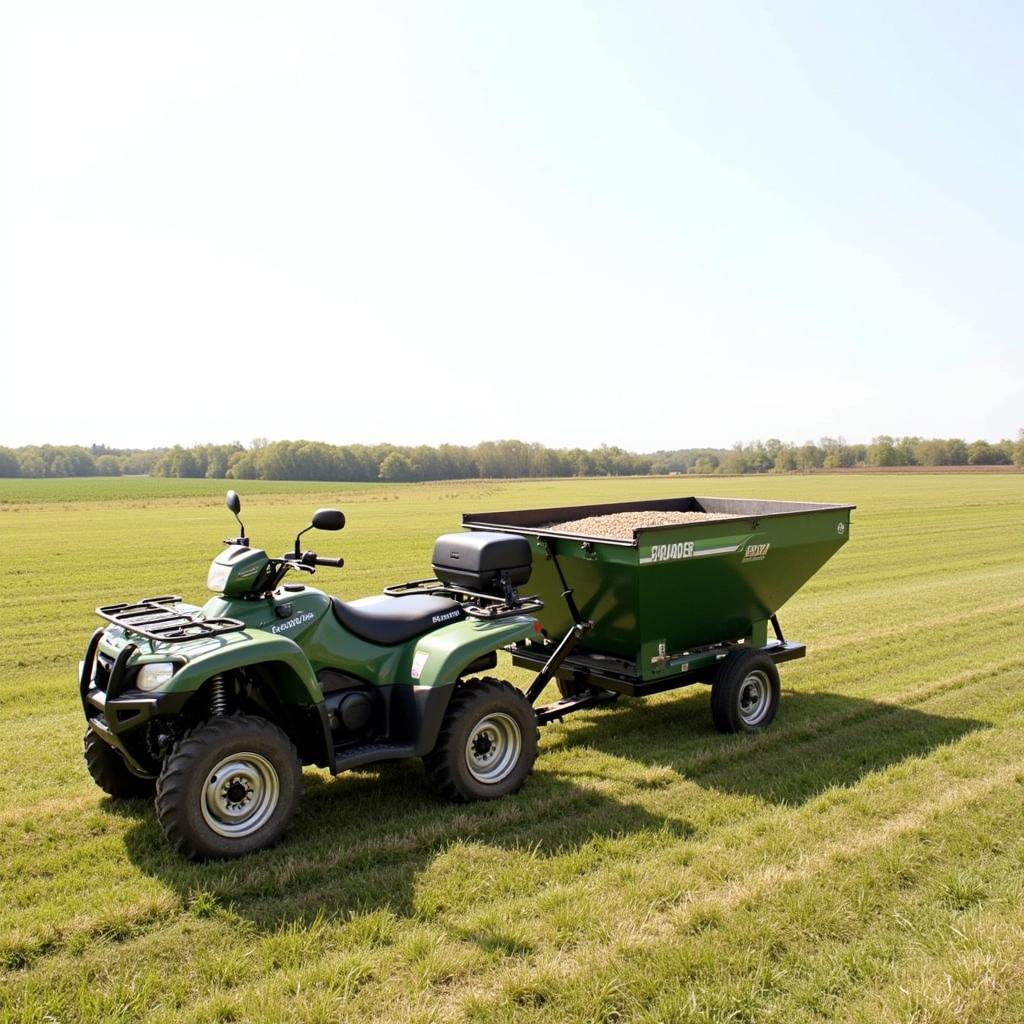Knowing how to attract wildlife to your land is an art form, and a successful food plot is a masterpiece. Whether you’re a seasoned hunter or a nature enthusiast, you understand that a thriving food plot hinges on the even distribution of seeds. This is where a Food Plot Seed Spreader comes in, ensuring your efforts translate into a flourishing food source for deer and other wildlife.
Why is a Food Plot Seed Spreader Essential?
Imagine painstakingly clearing your land, prepping the soil, and meticulously selecting the perfect seed mix, only to scatter them unevenly. The result? A patchy food plot with sparse growth that fails to attract wildlife. A food plot seed spreader eliminates this risk, providing:
- Uniform Seed Distribution: Even spreading ensures consistent germination and growth, maximizing the yield of your food plot.
- Increased Efficiency: Say goodbye to back-breaking hand-sowing! A seed spreader allows you to cover larger areas quickly and effortlessly.
- Optimal Seed Placement: Many spreaders come equipped with features that control seed depth and spread pattern, optimizing germination rates.
Types of Food Plot Seed Spreaders
Selecting the right spreader depends on the size of your food plot and your budget. Here’s a breakdown of the common types:
1. Hand-Held Spreaders
Ideal for smaller plots or those with limited access, hand-held spreaders are affordable and easy to maneuver.
- Pros: Budget-friendly, lightweight, and perfect for spot-seeding or reaching tight corners.
- Cons: Not suitable for large areas, requires more effort, and may not offer precise spreading patterns.
2. Broadcast Spreaders
These versatile spreaders are a popular choice for both small and medium-sized plots.
- Pros: Relatively inexpensive, easy to operate, and can handle various seed types and fertilizers.
- Cons: Can be less accurate at spreading seeds evenly compared to other types.
 Broadcast Spreader in Use
Broadcast Spreader in Use
3. ATV/UTV Spreaders
If you’re managing large food plots, an ATV/UTV spreader is a game-changer.
- Pros: Covers extensive areas quickly, offers precise spreading, and can handle large seed capacities.
- Cons: Higher cost, requires an ATV/UTV, and may be overkill for small plots.
 ATV Spreader for Food Plots
ATV Spreader for Food Plots
Looking for information about ATV/UTV implements? Check out our UTV implements for food plots page for more details.
Factors to Consider When Choosing a Seed Spreader
1. Plot Size
- Small Plots (under 1 acre): Hand-held or a small broadcast spreader
- Medium Plots (1-5 acres): Broadcast spreader or a smaller ATV/UTV spreader
- Large Plots (over 5 acres): ATV/UTV spreader
2. Seed Type
Ensure the spreader can handle the size and weight of your chosen seeds. Some spreaders are better suited for small seeds like clover, while others can handle larger seeds like corn or beans.
3. Terrain
Consider the terrain of your food plot. If it’s hilly or uneven, you’ll need a spreader that can handle the challenges.
4. Budget
Prices for food plot seed spreaders vary widely. Set a budget beforehand to narrow down your options.
Expert Insight: “Don’t underestimate the importance of a quality spreader,” advises John Miller, a wildlife biologist with over 20 years of experience. “Investing in a reliable spreader that suits your needs will save you time, effort, and ultimately lead to a more successful food plot.”
Maintaining Your Food Plot Seed Spreader
A well-maintained spreader will serve you for years to come. Remember to:
- Clean after each use: Remove any leftover seeds or fertilizer to prevent rust and corrosion.
- Store properly: Store the spreader in a dry, sheltered area to protect it from the elements.
- Inspect regularly: Check for any signs of wear and tear and address them promptly.
Conclusion
A food plot seed spreader is an indispensable tool for any landowner serious about attracting and sustaining wildlife. By understanding the different types available and considering your specific needs, you can choose the best spreader to create a thriving food plot that benefits both wildlife and your hunting experience. A thriving food plot starts with the right tools, and a food plot seed spreader is an investment you won’t regret.
FAQs
1. Can I use a regular lawn fertilizer spreader for my food plot?
While it’s possible, using a dedicated food plot seed spreader is recommended. Food plot seeds often vary in size and weight compared to lawn seed, and a specialized spreader ensures optimal distribution.
2. How often should I calibrate my seed spreader?
It’s best to calibrate your spreader at the beginning of each planting season or whenever you switch seed types. This ensures you’re applying the correct amount of seed for optimal results.
3. Can I use a hand-held spreader for a 2-acre food plot?
While possible, it would be physically demanding and time-consuming. A broadcast spreader or a smaller ATV/UTV spreader would be more efficient for a plot of that size.
4. Where can I find parts for my food plot seed spreader?
Most manufacturers offer replacement parts for their spreaders. You can also find generic parts at many farm supply stores or online retailers.
5. What is a drag for food plots, and do I need one?
A drag for food plots is a tool used to smooth the soil surface after broadcasting seeds. While not always necessary, it can help improve seed-to-soil contact and promote better germination.
Interested in exploring other food plot equipment options? Visit our website for information on food plot tillers and food plot planters for ATVs.
Need help choosing the right food plot implements? Contact us at 02437655121, email us at minacones@gmail.com, or visit us at 3PGH+8R9, ĐT70A, thôn Trung, Bắc Từ Liêm, Hà Nội, Việt Nam. We have a dedicated customer support team available 24/7 to assist you.